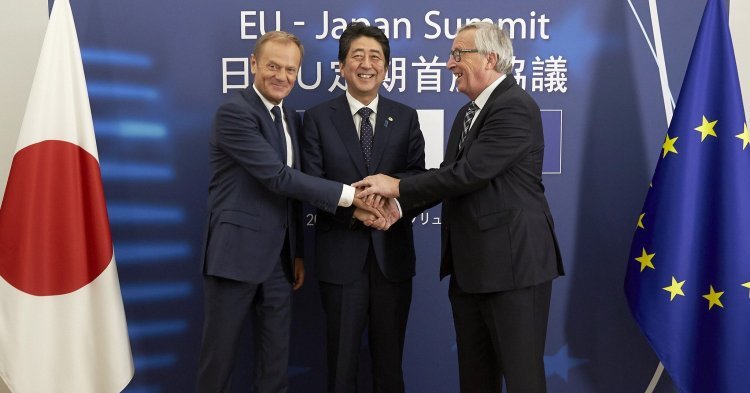During the negotiations between the EU and Japan, several factors played an important role in making it possible to reach an agreement: factors related to political considerations, the automobile industries in the EU and Japan, and the nonexistence of a investment protection mechanism in the agreement. In addition to others, I am going to explore to what extent the aforementioned factors facilitated the negotiation process of the EPA.
Investment Protection Mechanism
One of the factors which contributed to reaching an agreement is that the EPA did not include investment protection standards, and their negotiations take place outside the framework of the EPA. If the EU and Japan had pressed to include investment protection in the deal, this would have caused a non-agreement due to how important this aspect is to both parties, and to the EU and Japan asking for different mechanisms. The EU was asking for an investment court system (ICS), which is open to receive disputes, while Japan preferred the traditional way of "investor-state dispute settlement” through binding arbitration.
However, the EU is working with other partners, including Japan, to set up a Multilateral Investment Court through its reformed ICS. This has an important role at Member State-EU level, as by excluding the investment protection mechanism, the ratification process will only need the approval of the European Council and the European Parliament without national parliaments, which takes less time.
Political considerations and Brexit
Political considerations have also influenced the negotiations. For instance, the official name of the agreement, “Economic Partnership Agreement”, does not even contain the word “trade”. This aims to indicate strategic partnership and deep cooperation between the EU and Japan not only for trade, but on many different levels. The Commissioner of Trade, Cecilia Malmström, said: “the agreement represents not just a trade deal; but a strategic alliance between the EU and Japan”.
Reaching an agreement was very significant for both the EU and Japan at an international level, and as a part of the overlapping ‘win-set’ in which the EU wants to prove its leadership in setting global standards – especially at times when there is a rise in the level of protectionism. The EU wants to make it clear to others that free trade, cooperation and integration are still possible. Likewise, Japan also wants to fill the gap created by the United States suspending the talks of the TTP, by agreeing on a free-trade agreement with a huge economy and a major actor, the EU.
Indeed, political considerations were also marked at EU level. As the term of the current Commission will come to an end in late 2019, this also explains why the negotiations have moved quickly, an agreement was reached and the entry into force is before the end of the Commission’s term. However, having this short a period to ratify an international agreement is not sufficient. As said before, the Commission was determined not to include any mixed competence provision in the agreement, which would need approval of both the EU and national parliaments, and thus, would have taken more time.
Japan has important trade relations with the UK and most of Japanese investments in the EU go to the UK. As a result, Brexit has also influenced the negotiations, as Japan fears losing access to the single market once the UK leaves the EU. The EPA can provide an important opportunity for Japanese companies in the UK to export to the single market and therefore, this agreement can be a very beneficial backup for Japanese companies residing in the UK when the UK leaves. [1] Moreover, Japanese companies in the UK will of course have the opportunity to relocate their activities into the EU, which offers them direct access to the EU’s market.
European Social Fund (Member State-EU level)
The European Social Fund (ESF) has largely supported the trade deal between the EU and Japan, as it will offer new market access for European services companies in Japan. Furthermore, the ESF has pushed for services negotiations with Japan on a negative list approach, which later was included in the EPA.
Contrarily, there were other interest groups and civil society organisations all around Europe which opposed the negative list approach, such as PowerShift e.V. in Germany, Les Amis de la Terre in France, Centrale Nationale des Employés in Belgium and many more. They argued that this method severely limits governments’ ability to create, expand, and regulate public services and reverse failed liberalisations or privatisations, and makes it extremely hard to protect high-quality services such as water, transport, education, social and healthcare.
Food sector and limited public opposition (Member State-EU level)
The food sector in the EU is one of the biggest winners of this agreement, as the Japanese market imposes a high level of tariffs on EU imports of food and drinks such as cheese, wine, chocolate, and meat. The EPA was described as the agreement of ‘cars for cheese’ referring to the win-set of offering access to Japanese automobiles into the EU in return for reducing and eliminating tariffs on food and especially cheese.
French liquor suppliers have supported the deal since it brings higher profits once tariffs on wine and sparkling wine are eliminated when the agreement enters into force. For EU exports of processed food and dairy products, the Commission stated that these exports are expected to rise by 10 billion euros once the deal is in force. Thus, several European companies will benefit from the deal, including Danone, Nestle, and Lactalis. However, for Japanese dairy companies including Meiji and Megmilk Snow Brand, this means a greater competition with European companies, as they are highly protected by tariffs of 40% on processed cheese, which will gradually fall. This draws their attention to the possibility of losing customers in their market in favour of European companies.
The success of the negotiations was also enhanced by the limited public opposition to the EPA, in comparison to CETA for instance. Different interest groups and trade unions were not able to stimulate a reasonable opposition to the agreement, and this can be explained – as mentioned above – by the fact that the investment protection and dispute, which is one of the most contentious issues, is going to be negotiated outside of the framework of the EPA, unlike in the CETA. [2]
Automobile industry (Member State-EU level)
Both the EU and Japan are the largest car importers in each other’s markets, which means that they have a similar position when it comes to competition. With transition periods of up to 7 years before customs duties are eliminated, this can open the Japanese market to the European car makers, whilst at the same time keeping a highly competitive position for dominant automobile companies in Europe, as midsized Japanese companies entering the EU market would not pose an enormous threat.
The European Automobile Manufacturers’ Association (ACEA) consisting of BMW Group, Fiat, Renault and Volkswagen stated its support to the agreement: “ACEA supports trade agreements that are free and fair, providing mutual benefits. The fact that the EU and Japan signed a free trade agreement (FTA) [...] is a positive signal for international trade”. Their support was also encouraged by having the opportunity to sell an EU-approved vehicle in the Japanese market without the obligation to conduct a costly modification.
Conclusion
This essay explored how political considerations marked by the rise of protectionism, and the withdrawal of the US from TTIP, positively affected the EPA negotiations. Both the EU and Japan have agreed on an extensive agreement in a reasonable period of time for such agreements. All the aforementioned factors provided a ‘negotiation-friendly’ environment which led to one of the biggest trade deals ever negotiated by the EU, and it provided both sides with mutual incentives and market access which is vital for their economies.


Follow the comments: |
|
